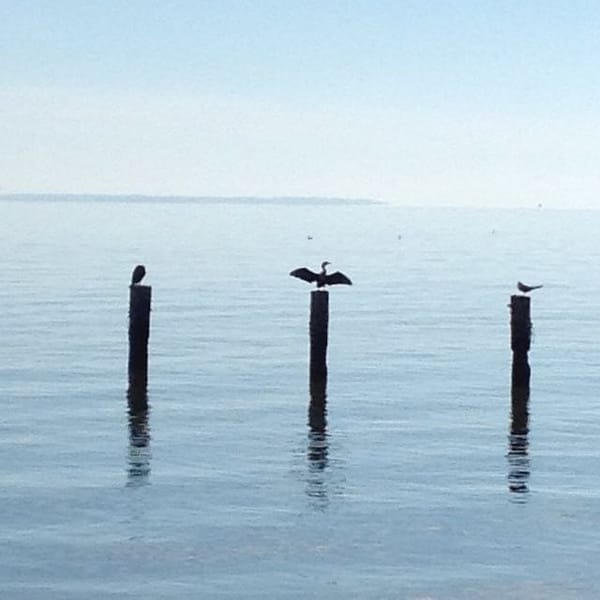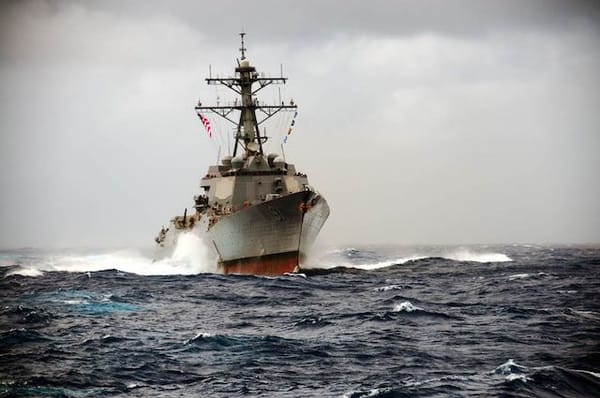Faking It, Part 3

A story of our own expectations, by Ian, continued from Faking It, Part 2.
This story was originally published on June 28, 2025.
OPS caught me right after breakfast on Friday morning.
“Well, sir, last night we were able to complete the flight deck events that we had planned for this morning, so the schedule is fairly empty. Our harbor pilot pickup time is not until 1400. We’re not that far from the harbor entrance. So, I would like to call port operations and see if they have an earlier time for us. What do you think about getting the crew home a little earlier?”
Easy. I’d seen captains do this a hundred times throughout my career, and even had to do it myself when I was an operations officer. The crew worked hard and they deserved the break.
“Sounds good, OPS,” I replied. “Make it happen.”
And he did. Within a few minutes our pilot pickup time shifted to 1200 at the Coronado Bay Bridge, so we had to arrive at the sea buoy by 1100 and set the sea and anchor detail at 1000. It was 0800. OPS had plenty of time to get everything in order, so I drifted up to my bridge wing chair, put my feet up, and for a few minutes enjoyed a strong cup of coffee in the morning light. I could feel the energy rising as the word spread about our earlier arrival. The watch team started its preparations and, satisfied, I roamed the decks before heading back to my cabin.
The time came to man the sea and anchor detail and, as usual, the crew buzzed and I had nothing to do. I tried to savor a few more minutes alone in my cabin until, at about 1015, I made my way topside.
The pilothouse was a Wall Street trading pit during a market crash, all crinkled papers, ringing phones, and desperate shouts. Small boats and pleasure craft spread across the horizon near the channel entrance. A surfaced submarine two miles ahead of us churned up a giant wake as it cut through the water with the elegance of a baseball bat. This seemed normal for San Diego on a Friday morning, and certainly no cause for panic. I approached the OOD to find out what happened.
“Flight quarters, flight quarters, all hands man your flight quarters stations!”
That announcement clamped my feet to the deck and slapped me in the gut with a cold, wet fish.
The helicopter. We never launched it. There couldn’t moor with it still sitting in the hangar, so we had to get it off the deck before we entered the channel at 1100. I looked up at the environmental indications and saw winds well outside the envelope for a safe launch. We would need to turn south, away from the channel and into the wind. It was now 1020 with the sea buoy 7 miles away. If not for the helo launch we would get there on time with a cool 11 knots. But for every minute we went out of our way to get the right wind, we would need more speed to get to the buoy on schedule.
“Get them down there now – we’re running out of time!” The OOD made a show of his frustration, slamming the phone into its cradle and trying to appear as angry as he thought I would be, like he expected me to chew him out for his lack of planning. The fact is, yes, I felt anger, but more at myself for being so clueless. Raising my voice would have been purely cathartic, a way to vent my shame into another person’s face.
Trying to conjure my best Chester Nimitz, I looked at the OOD and smiled. “What’s your plan?”
His head snapped left and right looking for something to look for. Then he said, “I’ve got to figure out the course we need to launch the helo, then the time, speed, distance to get back to the buoy.”
“Alright,” I said, now certain he did not have a plan. “You don’t need to do it all yourself. Have someone give you a course and speed recommendation for winds. And have someone else keep track of the speed we’ll need to get to the entrance on time. Let me know what you intend to do once you’ve had a chance to put your plan together. And hurry.”
After a week of helicopter operations, the flight deck team manned in short order. We just needed to get the winds right. It was 1030. We were now five miles away.
“Sir,” the OOD reported. “We need to come to one eight zero at 10 knots to get winds in the envelope. The helo will be ready to launch shortly. We should be just under six miles from the channel when we’re done in 10 minutes, giving us a speed of 16 knots to get there on time.”
“Make it so,” I told him.
The ship turned to starboard and heeled to port and the wind came into the envelope. Open sea lay before us. We waited for the helo to launch.
And we waited. And waited.
“What the hell is going on back there?” I snapped.
“The flight deck is reporting that the pilots need to run through a couple more checks before they’re ready for launch.” The OOD’s eyes locked onto his finger running furiously across the checklist.
I got out of my chair and looked at the chart. We headed due south, away from the channel entrance now six miles to the east, with every second bringing us closer to Mexican territorial waters, now six miles to the south. We needed to launch soon or we would miss our pickup time and end up in Mexico.
“Officer of the Deck,” I scowled. “What do you think?”
He froze for a moment. I had the impression he just wanted me to yell at him and tell him what to do. “I don’t know, sir,” he mumbled. “We just need to launch the helo.”
Wrong answer.
I had imagined myself as the captain of a ship with officers who could create plans, make decisions, and take action without me. I wanted them to feel free to act, to simply report what they were about to do so I would have a chance to say “no” if necessary. I wanted them to feel they commanded their divisions, departments, and watch teams. But the last week – and undoubtedly the last few minutes – proved they were not ready for me to lead that way. And I had not made them ready.
I let them down. I could not allow them freedom I had not yet taught them to handle. And, for the second time in a week, I failed to take timely action. I clenched my fists and tightened my jaw, struggling to clamp the lid on my boiling insides.
“Goddammit!”
The word shot from my mouth like hot knives as the restless soul of Captain Bligh found my raging body to possess. I would become, at least for the moment, the kind of captain I hated but they needed. I would order. They would follow.
“Slow down to bare steerageway until the helo is ready to launch. That will keep us from getting farther away from the channel and closer to Mexico. Come back to 10 knots when they’re ready.” I turned my head and smashed him with my eyes.
He gave the order and we slowed. A moment later, the flight deck requested permission to launch. We increased speed. I ordered green deck and the helo cleared to port. It was now 1043 with us about five and a half miles from the channel. We needed 20 knots to get there on time.
The ship now came left to face Point Loma with increased speed. The submarine made its way there ahead of us, our courses converging on the channel entrance. The bridge team looked stressed, their minds locked. It seemed every one of them tried to look engaged while silently waiting for my next order.
“Find out that submarine’s intention. If they’re going in ahead of us, arrange to pass them on their starboard side so we can get into the channel first.” Clockwork people obeyed.
The submarine captain agreed to let us pass. Given the distance, we would need 27 knots. We were now three miles from the channel and six miles from land. At that speed we would run aground in 12 minutes.
“Make it so,” I growled.
For the first time, I noticed Mike talking to the Navigator. He’d been there the whole time, of course, and seemed to be the only one not under a spell that made him stupid. He looked like a coach moving from person to person, talking them through what they needed to do and getting them to focus, getting them to smile. He did what I had always done when I was an Executive Officer – soften the blows from the captain’s fury. I felt relief at Mike’s presence, which quickly opened up a flood of humiliation. It only took a week to become the kind of captain a crew needs protection from.
The submarine slowed to 5 knots while we passed at flank speed 700 yards off her beam, about a mile from the channel.
“Navigation recommends course three five three, on my mark.” The Navigator, Lieutenant Stephen Petrov, made his report with confidence. I hoped he kept his head about him.
Our next turn, to the left, would cut us right in front of the submarine we just passed. But did I order the appropriate speed? How far would we be when we made the turn? Would we cause a collision? What’s the tactical diameter of the ship? How much rudder should we use? My mind seized. Life got all pixelated and choppy, my brain buffering from a weak connection to reality.
Stephen’s voice came from behind me. “Mark turn.”
“Wait,” I ordered as I ran out to the port bridge wing with the Conning Officer and the OOD. Mike followed.
The submarine looked too close, but how close? I failed to look at the radar in my rush.
“Captain. We’re exiting the channel,” Mike said as we cut a line nearly perpendicular across it.
The beach loomed three miles directly ahead. We would run aground in six minutes at our current speed.
He looked at the submarine, then back at me. “They’re about a thousand yards away. We have plenty of room.” It seemed now he tried to calm me. To protect me from myself.
On the radio I heard the submarine’s captain. “Warship Six Three One, are you … still planning to turn?”
“Right. Ok,” I said more to myself than to Mike. I looked at the conning officer. “Slow to 15 knots and put the rudder over left full.”
He did so, and the ship heeled to starboard in a 170 degree turn to port taking us back toward the channel from the opposite direction, with red buoy number four just off the starboard bow. The Conning Officer confessed, “I don’t know what we’re trying to do, Captain – this is the first time I’ve done this.”
“We’re going to take that red buoy down the starboard side. As soon as you see it even with the J-bar davit on the foc’sle, order a right full rudder. Then we’ll steady up in the center of the channel,” I told him.
He saw the buoy. He marked the turn. Johnston came about slow.
“Increase your rudder to hard right,” I ordered.
“Increase your rudder to hard right, steady on course three five three,” he repeated to the helmsman. The ship lined up with the visual range, dead center in the channel.
Silence gripped the pilothouse. Normally, it’s the mark of a well-trained team to have a quiet bridge with minimal distraction, hearing only standard orders and reports, and brief, subdued discussions with the XO or Captain. But this sounded like fear and doubt: the vacuous silence of everyone holding their breath.
I gathered the OOD, Junior Officer of the Deck, and Conning Officer centerline on the bridge and said something like we’re right where we need to be, or take a deep breath and bring her in just like you briefed, or some other lame attempt to keep them focused. They seemed to settle down, but I doubt they believed me.
I kept my hands in my pockets to hide the shaking and sat in my chair hoping for the next forty-five minutes it would swallow me.

By some cosmic act of mercy, we made it safely pier side. With all lines singled and main engines shut down, all the supervisors from the controlling stations came together on the port bridge wing for a debrief: We forgot to launch the helo earlier, but that turned out ok. We missed the turn into the channel, but made up for it with good ship handling. Communication could have been better. Overall, a good, safe evolution.
This, of course, was complete bullshit. We had just executed one of the worst transits I had seen at any point in my eighteen years of active duty.
I was learning one of the most difficult things about command: the captain rarely gets honest feedback. People might tell a captain when things go well, but most times all anyone says is, “Yes, Captain.” It is very unnerving.
If I wanted the real scoop I would have to ask for it specifically, assuring them over and over that I want the bad news, that the ugly truth is far better than the pretty lie, that we need to know our real troubles so we can fix them, and – most importantly – that I would never lash out at them for telling me the truth. And I had to mean it. If I would ever react poorly to bad news, the word would spread like a contagion and no one would ever be honest with me again.
Lieutenant Petrov stared at the ground with a look like somebody cinched up his face with a drawstring.
“What’s on your mind, Stephen? Really.”
He raised his eyes to meet mine, sighed, and opened up for everyone to hear: “I never thought we were unsafe or in extremis. I just think we didn’t do right by the name Johnston.”
That hurt, as the truth usually does. We drove our ship like a bunch of ass clowns, and that submarine would now and forever keep its distance from DDG 631. We had to do better.
No. I had to do better.
“Nav, you’re absolutely right,” I confessed. “Thank you.”
This is a fictional post based on true events.
Have a question or any feedback? Please leave a comment - I'd love to hear from you!





